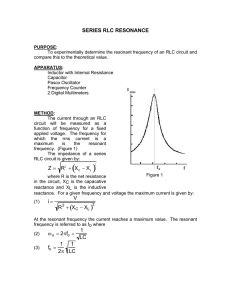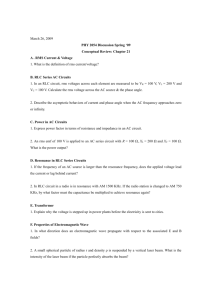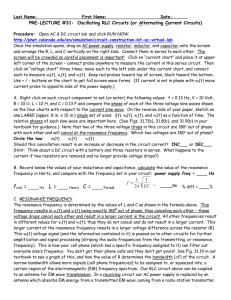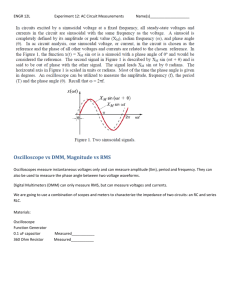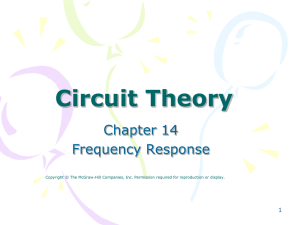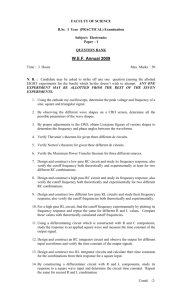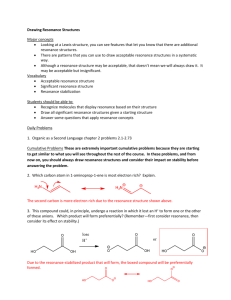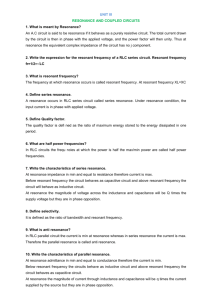Assignmnet exp.7
advertisement
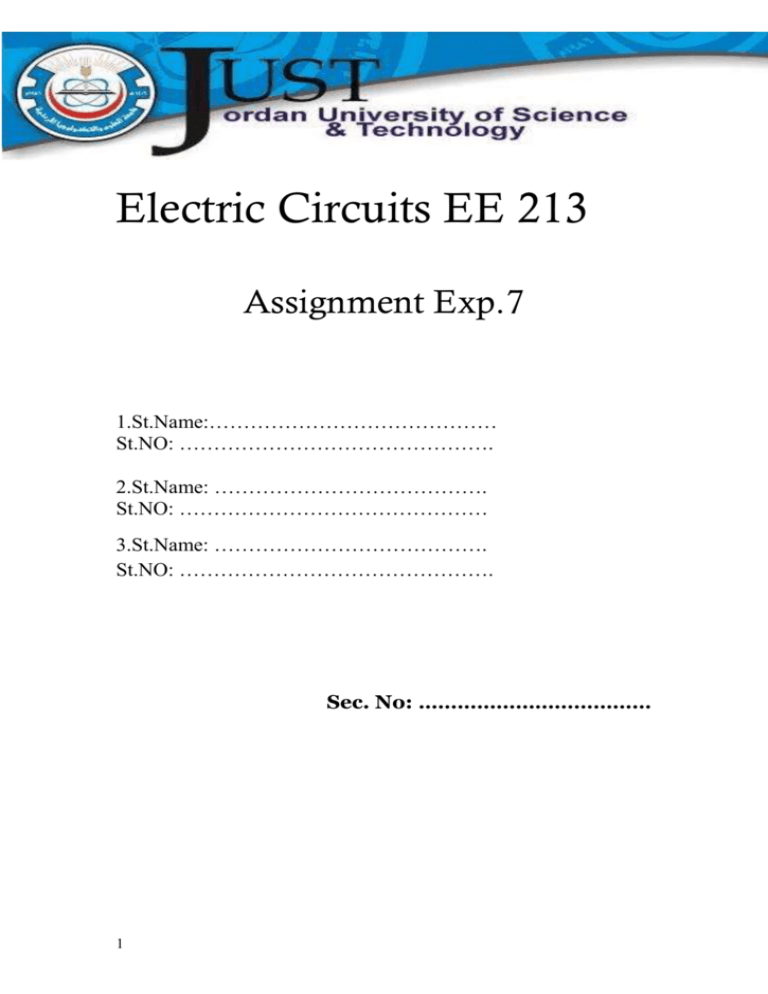
Electric Circuits EE 213 Assignment Exp.7 1.St.Name:…………………………………… St.NO: ………………………………………. 2.St.Name: …………………………………. St.NO: ……………………………………… 3.St.Name: …………………………………. St.NO: ………………………………………. Sec. No: ……………………………… 1 Objective: 1. Measure the input impedance and current response of an RLC series circuit and the input admittance and voltage response of an RLC parallel circuit as functions of frequency. 2. Determine the resonant frequency ω0, the half-power frequencies ω1 and ω2, the bandwidth , and the quality factor Q0 from the measured responses. 3. Measure the effect of L and C on ω0, and the effect of R on and Q0. Series Resonance A series RLC circuit driven by a variable-frequency source, where RL represents the dc resistance of the practical inductor used. The total series circuit resistance is: Rs = R + RL The current transfer function is given by: 𝟏 (𝑳 ) 𝒔 𝑰𝒔 (𝒔) = 𝑽𝒔 (𝒔) 𝒔𝟐 + 𝟐𝜶𝒔 + 𝝎𝟐 Where : 𝛼 = 𝑅𝑠 /2𝐿 is the damping coefficient 𝜔0 = 2𝜋𝑓0 = 1/√𝐿𝐶 is the resonant frequency The damping ratio, : =( Rs )√C/L 2 The input impedance: 𝑍𝑠 (𝑗𝑤) = 𝑅𝑠 + 𝑗(𝜔𝐿 − 1 ) 𝜔𝐶 The quality factor, Q0: 𝑄0 = 𝜔0 𝐿 = 1/𝜔0 𝑅𝑠 𝐶 𝑅𝑠 The magnitude and phase angle of Zs (jw) are given by: 2 |𝑍𝑠 | = 𝑅𝑠 [1 + 𝑄02 ( 𝜔 𝜔0 2 1/2 − ) ] 𝜔0 𝜔 And ∠𝑍𝑠 = 𝑡𝑎𝑛−1 [𝑄0 ( 𝜔 𝜔0 − )] 𝜔0 𝜔 1. Construct the circuit shown below with C = 0.1 µF and L = 0.1 H. 2. Measure the dc resistance RL of the inductor. RL = 3. Use a decade substitution box for R, and set it so that R + RL=200Ω. 4. For Vs, use the sinusoidal output of the function generator (FG) and set it to 5V rms with a digital multimeter (DMM). (Make sure this value is maintained when the test frequency is varied). 5. Apply Vs to oscilloscope Ch 1 and VR to Ch 2. 6. Use Vs as a source of trigger and as a reference in measuring the phase angle of VR=R Is by the time difference method. 𝑡2 − 𝑡1 = 7. Measure the rms values of VR , VL and VC with a DMM. VR VL VC 8. Starting at about 100 Hz, increase the FG frequency while observing the phase angle of VR. When this angle becomes exactly zero (at resonance), measure the period of the input voltage. T= 9. Note the frequency dial setting on FG: ---------------10. Ensure that Vs is still 5 v rms and measure other voltages with DMM. 3 VR VL VC 11. Increase the frequency until | VR | decrease to about 90% of its Maximum value at resonance. 12. Measure the phase angle of VR:--------------------13. Measure the period of Vs:-----------------------------------14. Measure the RMS voltage as before VR VL VC 15. Repeat for | VR | = 80,70.7, 50,30and 10 % of its value. 16. Measure the phase angle of VR:--------------------17. Measure the period of Vs:-----------------------------------18. Measure the RMS voltage as before VR VL VC 19. Repeat these measurements for frequencies below the resonance. 20. Change the value of R so that R + RL = 1K Ω. 21. Set Vs to 10-v rms and repeat the above measurements. 22. From these measurements data, Determine ωo ω1 ω2 ß Qo α ϛ 23. Compare with theoretical calculations using circuit-elements values 24. Determine: | VL/Vs | = 4 | VC/Vs | = At resonance and compare with Qo. 25. Plot | Is| = |VR|/R 26. Plot |Zs|=|Vs/Is| = 27. Plot the phase angle of VR vs ω using a logarithmic scale for ω. 28. Set R to 250 Ω and L = 0.1 H. 29. Measure the resonant frequency for C = 0.05 μ F C = 0.2 μ F C = 0.4 μ F 30. Repeat for C fixed at 0.2 F L= 0.05 H L = 0.2 H L = 0.4 H Parallel Resonance 1. Construct the circuit shown below with R = 2 KΩ, L = 80 mH and C = 80 n F. 2. Set Vs to 10V rms and make sure it is constant during all measurements. 3. With Vs on the Oscilloscope Ch1and Vp to Ch2, Observe the phase difference between them while you increase the source frequency from 100 Hz. 5 4. Resonance is reached when the phase difference becomes exactly zero. At this point measure the period of the source voltage and the RMS value of: VP IL IC T 5. Increase the frequency above resonance, and repeat the phase and current measurements with |VP| Decrease to: Phase VP IL IC T 90 80 70.7 50 30 10 of its maximum value at resonance. 6. Decrease the frequency below resonance and repeat. 7. From these measurements data, Determine ωo ω1 ω2 ß Qo α ϛ 8. Compare with theoretical calculations using circuit-elements values 9. Determine: | IL/(Vs/R) | = | IC/(Vs/R) | = At resonance and compare with Qo. 10. Is large enough to justify approximate calculations? ---------------------------------------------------------------------------------------------------------------11. Plot | VP| 12. Plot | VP| = │(Vs/R)/VP│ 13. Plot the phase angle of VP vs ω using a logarithmic scale for ω. 6 Conclusion: 7
